Nearly everyone is aware of Coleman Barks’ bestselling English versions of the Persian poems of Jalāl ad-Dīn Rūmī, and most educated readers of Barks are
by now aware that his “translations” are not translations at all, Barks having no Persian: they are retooled versions of earlier English translations. [1] But we forgive Barks the false advertising found on the title pages of his works (“translations by
. . .”) because he has several times in print admitted the truth of the matter, and because his poems based on Rūmī’s are so often very good, providing
spiritual inspiration without departing too far from the original.
We have examples in the same field of clear-cut intellectual dishonesty, however: Daniel Ladinsky has published several volumes of poetry that claim to be
versions of Ḥāfez Shīrāzī (aka Hafiz), but scholars of Persian can’t seem to identify which of Hāfez’s poems inspired which of Ladinsky’s, so distant are
the latter from the former. Indeed, polyglot translator A.Z. Foreman has written a lengthy, scathing review of Ladinsky that argues he is simply an
out-and-out fraud passing off his own work as someone else’s (since that someone else is so much more prestigious). [2]
Both Barks’ and Ladinsky’s publications exist at different places on the spectrum of cultural appropriation, which essentially refers to a member
of one culture borrowing elements of another culture and repurposing them in a way that to some degree distorts their meaning—often in a way that indicates
that the appropriator is ignorant of, or insensitive to, the meaning of those cultural elements in their original context. Going further, cultural
appropriation is viewed in postcolonial and feminist theory as oppression when the borrower is the member of the cultural majority and is
appropriating from a marginalized or minority culture, such as one that was previously colonized by the majority culture (e.g. India).
The American yoga and kirtan scene is of course rife with cultural appropriation that implies insensitivity to traditional Indian culture. This fact is
spoofed in clever Internet memes like ‘Gandhi Does Yoga’ and exemplified by privileged white “kirtan artists” that mispronounce, mistranslate, and even
fabricate mantras, as well as by countless American “yoga” teachers that have only the most superficial understanding of the cultural background of the
very practice they are trying to teach.[3] Some appropriators, like Leslie Kaminoff, justify their
appropriation with specious arguments that yoga is not really Indian because it is part of nature
itself, and therefore was not invented but only discovered by Indians.[4] In fact, though yoga addresses and
interacts with biological bodies and minds, it is a cultural product and can only be understood with reference to the culture that birthed it and shaped it
for 99.9% of its lifetime so far. People who comment on the nature of yoga based on their knowledge of literally 4% of its history are displaying not
only unintentional hubris, but also lack of awareness of the degree of education required by the tradition itself in order to be qualified to
speak on it and represent it.[5]
Sutra Journal has, since December, been publishing the work of Lorin Roche, an author and poet who I argue is also a cultural appropriator, one closer to
Ladinsky than Barks on the spectrum because like Ladinsky he is, in my view, guilty of a subtle kind of intellectual dishonesty as well. The present
article seeks to demonstrate the validity of these statements.
--- Let me take a moment to applaud Sutra Journal for being willing to publish authors with opposing views, since this generates the stimulating debate so
vital to the contemplative and intellectual life. ---
Specifically, Roche has appropriated a medieval Sanskrit text whose original title is the Vijñāna-bhairava-tantra (literally, “The Scripture of
the Bhairava who is Consciousness”)[6] and re-presented it as The Radiance Sutras, a book of
original Roche poetry presented in juxtaposition with the original Sanskrit text of the Vijñāna-bhairava in a move clearly calculated to imply to
the reader that it is a translation.
Now, since Roche knows well that the majority of his fans and followers assume he does understand the language, and he is careful not to disabuse
them of this assumption, wouldn’t this be a case of blatant intellectual dishonesty? It would, except for the fact that Roche believes that what
he has produced is just as valid as what any professional Sanskrit scholar might produce. This is because he believes that the text of the Vijñāna-bhairava-tantra mystically speaks to him and reveals its inner meaning directly, without necessity for grammar or book-learning. I will
explain below exactly how he goes about producing poems that often have little relation to the Sanskrit text while yet believing he has produced a valid
translation that captures the essence of the text.
The purpose of this article is not to attack Lorin Roche as a person; through mutual friends, I hear he is a warm-hearted individual and a good man, and I
am sure he has the best of intentions. Rather, critically examining Roche’s particular form of cultural appropriation will reveal to us fascinating
features of the American spiritual landscape and help us to understand how different that landscape is to that of India 1200 years ago, and why American
appropriators nearly always distort their Indian sources. Secondly, it will reveal (and explain) some common misunderstandings about the nature of the
Sanskrit language. Finally, it gives me the opportunity to offer suggestions to Westerners about how to approach the spiritual technologies found in
Sanskrit sources for personal spiritual benefit while simultanously respecting the source culture.
Why I am so interested in Roche’s appropriation in particular, when he is far from the most egregious appropriator? Because the text that he appropriates
is a central scripture of the Trika lineage of Śaiva Tantra, a lineage which I study professionally as well as practice within personally. It has therefore
disturbed me to see a sacred text of yoga from my tradition presented to the Western public as little more than a justification for hedonism
(i.e., mental or sensual pleasure as an end in itself). Even more importantly, I am concerned to alert readers to the fact that the real teachings
of the Vijñāna-bhairava, correctly translated, are doorways to liberation much more powerful and precise than readers of The Radiance Sutras could suspect.
Therefore in this article I attempt something unusual: it is both a critical commentary by a professional Sanskrit scholar and a demonstration that
scholarship and spiritual sensitivity are not mutually exclusive. I hope to provide the reader with a direct link to the teachings of the original
scripture and show that accurate translations can also be spiritually powerful. In this way, I hope to demonstrate that last century’s divide of scholarly vs. inspiring, accurate vs. juicy, intellectual vs. spiritual is no longer relevant. It is time to restore the connection
between intellectual rigor and spiritual inspiration that characterized Indian literature before foreign conquest. This article is a small contribution in
that direction.
First we will address specific problems in translation and cultural mediation, then I will present examples of accurate translation from the Vijñāna-bhairava-tantra, then discuss the implications of all that we have considered.
When spiritual practitioners who are not also trained intellectuals attempt any kind of translation or re-rendering of a foreign work (especially one from
the ‘mystic East’), they often read into the text what they wish to find there, while being unable to see that they are doing so, because of lack of both
linguistic competence and lack of historical awareness. In the case of Roche, many of his distortions of the original source are due to his (possibly
subconscious) desire to find his personal philosophy of hedonism in every verse of the Vijñāna-bhairava. [9]
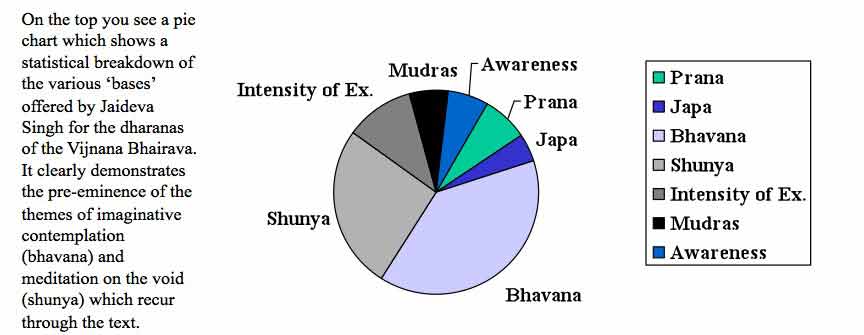
Notes: this chart, which I made a long time ago, is slightly misleading in that ‘Awareness’ should read ‘Pure Awareness’ (since
all
of the dhāraṇās involve awareness). In ‘Intensity of Ex.’, the Ex. stands for ‘experience’. Bhāvanā can also be translated as ‘contemplative
meditation’.
Roche reveals his Shakti-bias when he writes, “Each of these techniques is a way of attending to the rhythms, pulsations, and sensuousness of the divine
energy that we are made of and that flows through us always.” In fact, more than a quarter of the dhāraṇās (meditative techniques) in the text
focus on Shiva as the still silent void (śūnya) of pure awareness (see, e.g., vv. 43-49 and 58-60)! This seems to be almost a no-go zone for
Roche, who thus must do violence to his source in producing the poems he wants to attribute to it. He also wrongly states that “The language of the text
abounds in earthy humor and sexual innuendo,” again projecting his own predilections and preferences onto the scripture. (I’m sure any fluent Sanskritist
would agree with me that there’s little to no sexual innuendo in the text, though there are a couple of obvious verses about how to meditate on
sexual pleasure.)
Finally, he mischaracterizes the text as being unconditionally permissive,[11] when in fact it presupposes
the mental and physical discipline standard to all forms of yoga in the medieval period. In this he is simply dragging the text toward his
worldview, formed as it was in late 60s/early 70s California, an era prominently characterized by a “do whatever feels good” ethic and intensified sensual
experience through psychedelics, both of which are apparent in his poetry. Though the Vijñāna-bhairava-tantra certainly did greatly open up the
traditional range of possible doorways to the Divine, and is acknowledged as atypical and revolutionary for its time by scholars, it assumes a capacity for
subtle perception, self-awareness, internal quiet and self-control not typically found in the American yoga scene to which Roche’s book is marketed.
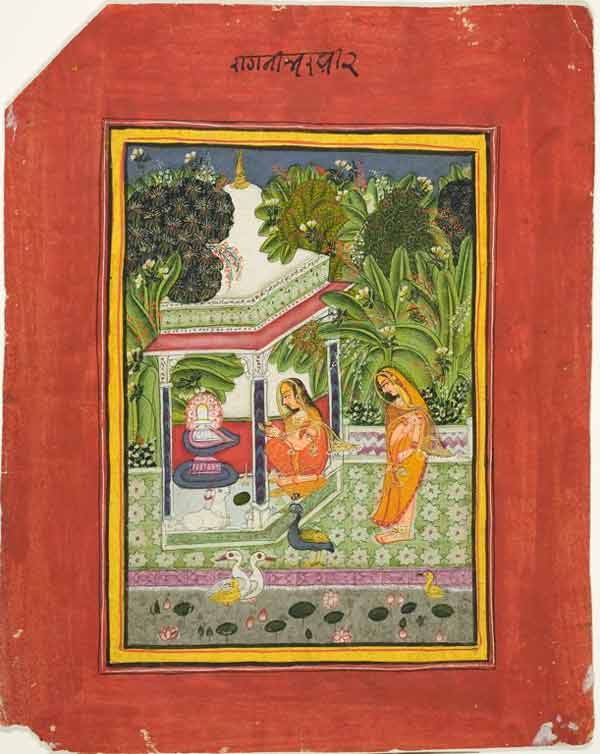
Bhairavi raga
The Problem of a mystical, anti-intellectual approach to Sanskrit
Needless to say, the risk of confirmation bias is greatly reduced if one can fluently read the language one proposes to render into one’s native tongue. [12] Here is where Roche exhibits intellectual dishonesty, for he speaks to his readers as if he is an
expert in Sanskrit language and literature when he is not,[13] as is obvious to anyone who’s studied the
language at the university level. Since he tells us he’s studied the text closely for the last thirty years, one wonders why in the world he didn’t bother
to do one or two years of university-level Sanskrit (e.g. at U.C. Santa Barbara, almost in his backyard), which is all it would take to understand the
register of Sanskrit used by the Vijñāna-bhairava-tantra.[14]
The answer to this question is startling, and personally leaves me astonished. Roche, like many American yogis, regards Sanskrit as a mystical language,
and clearly believes that unlike other languages, it yields its secrets to any sufficiently mystical person (like himself) without the need for
intellectual study (see endnote 15 for the evidence that this is really his view).[15] This, then, is his
method of ‘translating’: he memorizes a verse and repeats it over and over to himself (sometimes for weeks on end), then he looks up each word in a
Sanskrit-English dictionary and writes all the possible meanings found there on note cards and spreads the cards out on the floor (up to 250 cards per
verse) in a mandala-formation and then walks around and around them “until I feel the richness of the words vibrating in my body. Then I start to pray for
English words . . .” until a poem takes shape that uses as many of the words on his note cards as possible. [16]
This approach, admired by his followers for its thoroughness, reveals some common misunderstandings about the nature of Sanskrit. First, Roche is
fascinated by the polysemous, multivalent nature of the language; that is, the fact that most words have many different possible meanings. But he is
clearly unaware that only one of these meanings applies in any given context. I’ll explain. The dictionary he uses (Monier-Williams’ Sanskrit-English Dictionary, 1896) gives all the meanings a given word has ever had over millennia, including technical terms limited to specific
branches of literature as well as unattested meanings (i.e., those found in ancient Sanskrit lexicons but never actually used in texts). A Sanskritist
usually knows which meaning is relevant based on context. For example, the word tantra means ‘loom’ only in the context of a discussion
of weaving; in spiritual contexts, it means ‘doctrine’ or ‘framework’ or ‘system’ or ‘scriptural text presenting a specific doctrine and system of
practice’ (the latter being a usage specific to the Tantric movement). Like many other modern authors, Roche thinks that ‘loom’ or ‘weave’ is the primary
meaning of tantra because it occurs first in Monier-Williams’ dictionary (MW), but in fact, MW lists the oldest meaning first, not the
commonest meaning.[17] A Sanskrit reader who sees the word tantra in a spiritual text doesn’t
think of a loom any more than an English reader seeing the word ‘bark’ in a book about trees would think of a dog. And this is a crucial point: the
Sanskrit dictionary lists homonyms under one and the same entry; to think that any of the meanings could apply is as absurd as confusing the
meanings of the three distinct definitions of the English word ‘bark’ (relevant to the specific contexts of trees, dogs, or boats) or ‘key’ (relevant to
the specific contexts of locks, music, or islands).
Context determines which meanings are possible, yet Roche imagines that all the meanings found in the dictionary under a given word are relevant.
(It’s a strange error to make, since it implies confusion not only about the nature of Sanskrit, but about the nature of language generally.) This is why
he thinks that in the scripture under discussion “there are multiple layers of information reverberating in each word,” and further claims that “hundreds
of very different translations could be done. This is intentional.” In other words, he claims to know the intention of an author writing centuries ago in a
language that he doesn’t read!
In fact, his claim is fallacious. While translators equally competent in the language might debate about the intended meaning of verses that are
purposefully mysterious (as some are in the VBT), half a dozen competent translations would exhaust the range of possibilities. And not being sure of the
author’s intended meaning in every case is not the same thing as saying that the author intended many meanings. (In the case of the VBT, I am sure
s/he did not.) Sadly, we do not yet have even one translation of this text by a competent Sanskrit who is well-read in the literature that
parallels the VBT.[18]
Since many non-Sanskristists consult the MW dictionary, let me note here for their benefit (and Roche’s, if he reads this) some conventions MW uses:
· a definition followed by ‘L.’ is lexicographical, meaning that the word is never actually used with this meaning, despite the meaning being
listed in ancient lexicons
· a definition followed by ‘ifc.’ is only applicable if the given word is the last member of a compound
· meanings are listed in chronological order, so the first meanings are unlikely to be relevant unless you are reading a Vedic text. Meanings of words
shift over time, rendering older meanings obsolete or nearly so, but MW lists them as well. (Remember the text we are currently considering was written
2000 years after the Vedic texts, during which time there was plenty of gradual semantic drift, even in the slow-to-change Sanskrit language.)
Secondly, Roche wrongly thinks that the author of the VBT is constantly using the literary device of śleṣa: punning, double entendre, or
paranomasia. Not being a Sanskritist, he doesn’t understand what śleṣa actually is: for example, commenting on verse 1, he says: “If we
wanted to, we could hear mayā as word play (śleṣa), with the similar sound māyā.” This comment is revealing,
since that is absolutely not how śleṣa works. Mayā (“by me”) and māyā (“magic, etc.”) are unrelated
even if they sound similar to an English ear. Roche’s mistake is as basic as confusing the word ‘art’ (kalā) with the word ‘time’ (kāla).
In fact, śleṣa works by creating contexts in which two or three distinct meanings of a word are more or less equally applicable,
confusing the reader for a moment until his confusion turns to delight upon realizing the word-play. For an explanation and ingenious example of Sanskrit word-play, read this blog post. The author of the VBT rarely uses sophisticated
literary devices like śleṣa, wishing as he did to reach a wider audience of initiates, not all of whom were literary aesthetes.
Revealingly, Roche tells us: “I refer to The Radiance Sutras as a 'version’ rather than a ‘translation’ because I am following a different set of
rules than those developed by Indologists . . .” — that is, his own set of rules, rather than the rules of Sanskrit grammar. Yet he pretends to authority,
repeatedly implying that his poems are as valid a translation as any other, and displays them in his book under or side-by-side with the original Sanskrit
verses so as to imply that they ARE translations (see the image below). This is intellectual dishonesty, in my view; though there are some who disagree
with me.
In summary, then, Roche is an aesthete writing a book of beautiful poetry inspired by a text unconcerned with aesthetics, its sole purpose being to provide
seekers of liberation with new technologies. This is why his book does not represent or even correspond to the intention of the author of the VBT.
Discussing these issues provides us with a much-needed opportunity to illustrate the level of qualification needed to interpret Sanskrit texts. In the
original tradition, you had to master grammar (vyākaraṇa) before you could study any other art or science (śāstra) documented in
texts, for obvious reasons. Educating the wider public is a crucial mandate, lest people interested in Sufism study Ladinsky’s poems or people interested
in Tantra study Roche’s poems, both of which would be a waste of their time, despite the beauty of those authors’ poems.
Indeed, most of those who view my critique of Roches as harsh do so because they find pleasure in his poems. There’s nothing wrong with that—I like some of
them myself. But that is a completely separate issue. The poems have literary or artistic merit on grounds completely unrelated to whether they
convey the intentions of the author of the VBT. Anyone who authentically loves the poems will love them even without the superimposed mental frame
that they communicate the wisdom of an ancient text. And it’s only fair of me to point out that occasionally the poems do allude to or align with
the actual practice being taught in the corresponding Sanskrit verse, because Roche has studied all the available translations, and therefore, sometimes,
accurate pieces of translation are echoed by a given poem.
But here is the main point: readers who believe that they are accessing ancient wisdom by reading The Radiance Sutras (and after reading Roche’s
introduction to the book, who could blame them?) are being misled. It is a disservice to them to make them think that by reading this book, they have
access to the teachings of the Vijñāna-bhairava-tantra. They most certainly do not, and since those teachings deserve to be known (in my view), an
article setting forth the facts and offering accurate translations (for which see below) seemed desirable.
One of the readers criticized Matthew Remski’s Threads of Yoga, a ‘remix’ of the Yoga-sūtra, with these words: “The
reader is robbed of the work that will bring her insight—wrestling with the difficult ideas in the text—and instead invited to swoon for a poet.” This
exactly what I think is happening in Roche’s book.
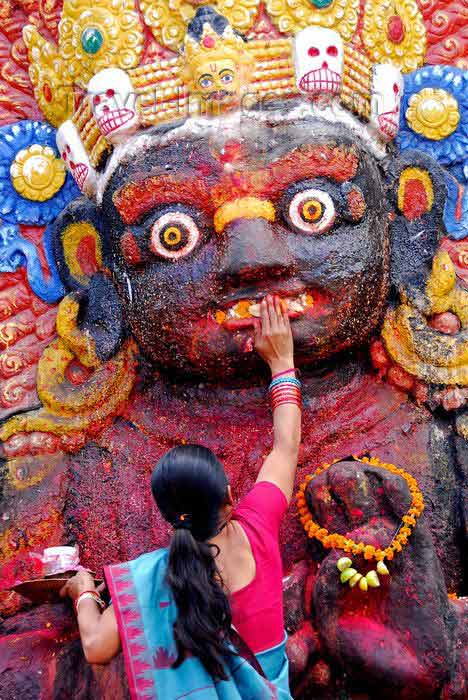
Bhairava, Kathmandu, Nepal
The real meaning of the Vijñāna-bhairava-tantra
Before addressing the wider cultural implications of Roche’s approach to spiritual literature, let us spend a few moments with the scripture itself. The
profound (and surprisingly modern) spiritual teaching of the scripture begins with verse 13, but Roche makes much of the first line of the text, wishing to
find in its simple language much poeticism. He renders śrutaṁ deva mayā sarvaṁ rudra-yāmala-sambhavam as “Shining One, I have heard that which has emerged from the intercourse of Rudra and his Shakti.” Now,
this is actually very close to the Sanskrit, as it happens; but rather importantly, it’s missing the subject of the sentence. In fact, the first line is
not a complete sentence. The logical subject (trika-bhedam) is found at the beginning of the second line of the verse, agreeing with sarvam in the first line. With it, we can translate the literal meaning of the sentence:
“O Lord (deva), I have heard (śrutaṃ mayā) the whole teaching of the Trika lineage (sarvaṃ trika-bhedam) that was
produced from our divine union (rudra-yāmala-sambhavam).”
The very first sentence of the scripture declares its context, a context appropriators like Roche prefer to obscure: it is a work that situates itself
within the Trika revelation of the Tantric movement. The primary deity of the Trika is Parādevī, a Tantric form of Sarasvatī. [19] This first sentence also declares the Kaula theology of the text, focusing as it does on the union and
balanced harmony of the apparently contrary complements Śiva and Śakti. Yet as noted above, Roche skews this balance in his poetry,
consistently privileging Shakti over Shiva, in accordance with the cultural bias of Californian yoga.
Let us go deeper. In the following verses (2-7), the Goddess asks about the ultimate nature of reality, and inquires whether it is encompassed by any of
the deities or mystical concepts revealed in the scriptures.[20] Surprisingly, Bhairava responds by saying,
Know that the embodied forms of the Divine that I have taught in the scriptures are not the real essence [of the Tantras], O Goddess. They are like a
sleight-of-hand, or like dreams or illusions or castles in the sky, taught only to help focus the meditations of those who are debilitated by dualistic
thought, their minds confused, entangled [as they are] in the details of ritual action.
(vv. 8-10)
He denies that any of the technical terms she has introduced encompass the true nature of reality, continuing,
These were taught to help unawakened people make progress on the path, like a mother uses sweets and threats to influence her children’s behavior.
[21]
Know that in reality, the one pure universe-filling ‘form’ of Bhairava is that absolutely full state of being called [Goddess] Bhairavī: it is beyond
reckoning in space or time, without direction or locality, impossible to indicate, ultimately indescribable, a sense-field free of ideation, blissful
with the experience of the innermost Self
(antaḥsvānubhavānandā).
When this is the ultimate Reality, who is to be worshipped, and who gratified? This state of Bhairava called Bhairavī is taught as supreme; it is
proclaimed to be Parā Devī in her ultimate nature.
(vv. 13-17)
In other words, the absolutely full state of awareness (bharitākārā avasthā) which Bhairava describes is the immediacy of a joyously expanded
field of awareness free of mental filters or projections; the opening to and welcoming in of the whole of the present moment without conditions; the
granting of the heart’s consent to the moment as it is, releasing mental fantasies of how it could or should be; and the feeling of deep connection and
presence that comes from surrendering into true intimacy with the qualia of reality as it offers itself and permeates awareness now. In this
state, one’s innermost being (antaḥsva) is revealed as it really is, permeating the whole of reality (viśva-pūraṇa)—an experience that
fills one with joy (anubhavānanda).
The radical nature of this revelation could only be appreciated through familiarity with the cultural context of the time, in which revelations of
ever-more esoteric deities was a game of sectarian one-upmanship. A plethora of complex ritual forms and injunctions is at once done away with in a
profound reframing of the purpose of spiritual practice: when we access the state of inner fullness, the state of liberated and expanded awareness, we are
engaged in the highest worship possible. This teaching became popular later and is still popular today, but in the year 850, it was unheard of. It was a
revelation.
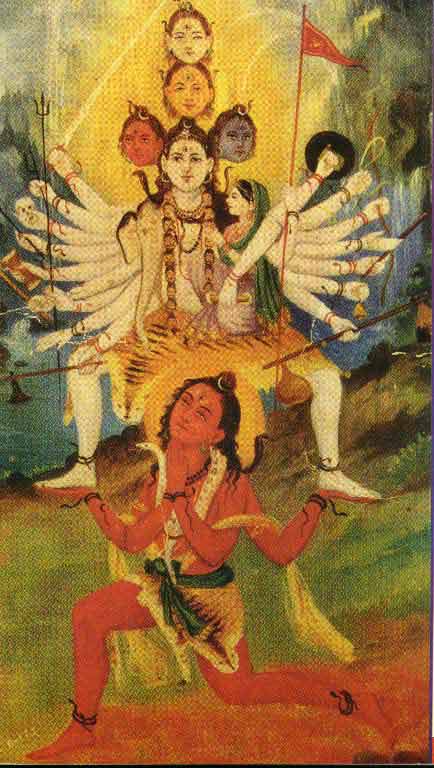
Svacchanda Bhairava
The practices of the Vijñāna-bhairava-tantra
In response to Bhairava’s teaching, the Goddess, as pragmatic as most yoginīs I know, asks:
“O God of gods, answer me this in such a way that I can completely understand it: How is this state of absolute fullness of the Divine—beyond space, time,
and locality, and impossible to represent conceptually—attained? By what means can one enter into it? And how does Parā Devī, the Supreme Goddess, become
that [entryway], O Bhairava?” (vv. 22-23)
Bhairava’s reply is the 112 techniques, practices, and contemplations that form the bulk of the scripture (vv. 24-136). These come in no particular order,
but it does seem significant that the first practice presented is a sublime meditation on the spaces between the breaths:
The Supreme Goddess [constantly] articulates herself as the creative flow of breath:
apāna (inhale)—the movement into embodiment—descending, and prāṇa (exhale) rising up. By ‘nourishing’ the two points where the inbreath and outbreath arise, that moment of stasis reveals Her in fullness. (v. 24)
This verse poses a fascinating challenge for the translator, because it is impossible to render it correctly without knowing the technical terminology of
Śaiva Tantra. For example, jīva means both the inhale and the creative ‘downward’ movement into individuality. Also, uccaret means both
to breathe (especially exhale) and to utter a mantra in sync with the breath. This is a usage not found in the dictionaries, since it is specific
to Śaiva Tantra.
By not turning back the inner and outer breaths [too soon] from the pair of spaces [where the breath pauses], the form of Bhairava [i.e. pure
awareness] manifests thus through Bhairavī [i.e.
prāṇa-śakti]. (v. 25)
The ‘pair of spaces’ refers to the two points mentioned in the previous verse: that from which the inhale begins (which is outside the body) and that from
which the exhale begins (deep inside the body). The inside of the body is visualized as open space, mirroring the outside. One is invited to pause ( kumbhaka) at the end of each inhale and exhale and experience the spaciousness of pure awareness.
Neither moving forth, nor entering in, the power (
śakti
) inherent in the breath is revealed in the Center [where it comes to rest]. Then, through the dissolution of thought-forms, the Bhairava-state
[appears].
(v. 26)
The ‘Bhairava-state’ is an experience of ‘emptiness’ that is paradoxically filled with the quiet intensity of pure presence. This experience happens in
‘the Center’, which of course refers to the central channel, the subtle core of one's being.
She moves out and rests; She moves in and rests. When the breath-power becomes still after exhalation or inhalation, then that [state] called 'peaceful
repose' (
śānta) [appears]. By that power [of the breath], peaceful [Shiva] reveals himself. (v. 27)
For whatever reason, I haven’t seen this verse translated correctly so far, and it’s just lovely. (An aside: taken together, these four verses seem to
undermine the text’s claim to teach 112 techniques, since here we seem to have one practice described and variously nuanced over four verses. I find other
instances where two or more verses are needed to explain a practice as well.)
Now we can at last turn to the handful of verses that Lorin Roche has written about here in the virtual pages of Sutra Journal. In his first article (Dec.
2015), Roche attempts to poetically render a difficult and subtle verse, #32. He presents his poem as a playful rendering, yet also claims to know the
inner meaning of the verse.[22] Literally, the Sanskrit
means:
“Meditating on the Five Openings as the colorful circles of the peacock’s feathers, one enters the Heart, the Supreme Space.” [23]
This obviously needs explication; traditionally, when unsure of the intended meaning, one looks first to the Sanskrit commentators on the root-text. A
Western appropriator like Roche is of course less likely to honor the strong cultural tradition of first consulting what earlier authorities have to say
about the verse. Fortunately, we have two such authorities to consult, Śivopādhyāya and Ānandabhaṭṭa. After pondering their opinions and consulting my
practitioner’s intuition, this is my interpretation of the meaning of the verse:
We first note that the five[24] sense apertures are commonly called ‘spaces’ or ‘openings’ (śūnya
), but they are separate, whilst the five circles (maṇḍalas) of the peacock’s feather are nested one inside the other. Since we are instructed to
meditate on the sense-apertures as the circles on the peacock’s feathers (a point missed by all available translations), that clearly implies that
we should allow the sense-fields to merge. The idea may be to intentionally nest the subtler sense-energies inside the coarser ones (i.e., sound-sense
nested inside touch inside visual-sense inside taste inside smell); or perhaps that level of detail is not intended here, and you are simply supposed to
let them all merge into a single sensual field, as if you had a single sense-aperture.[25] All phenomena
within the sense-field, then, are to be perceived as vibrations within vast emptiness (the ‘Supreme Space’), the innermost Heart of Being, pure Awareness
itself (= Bhairava).
Now, at the center of the nested circles of the peacock’s feather (see image), you see an incredible iridescent cobalt blue, and probably not
coincidentally, this is the traditional color of Anuttara Śiva, absolute consciousness. The verse explicitly says that through this meditation, one enters
the anuttara śūnya, the Supreme Space, the absolute Heart. As far as I know, no one has noticed this correspondence yet.

Verse 39 offers another example of a very specific yogic practice important to the tradition but unknown to Roche (and unknown to most translators as
well). The verse clearly alludes to the central Tantrik practice of uccāra, in which the yogī repeatedly devotes a prolonged exhale to a
single-syllable mantra (praṇava or bīja) such as Oṃ. Specific techniques are involved with this practice, and the scripture is not
innovating when it invites the practitioner to meditate on the silence immediately following the prolonged sound of the mantra. Through this meditation, we
are told, the yogī attains perfect emptiness (śūnyatā). In all fairness we should here note that the Roche poem inspired by this verse is not only
aesthetically pleasing, but actually is fully aligned with the original intention of the verse; though of course he cannot convey the subtleties of the
practice of uccāra (and nor can I, through the medium of the Internet).
However, in his version of verse 67 (SJ, Feb. 2016) he radically misrepresents the scripture. His poem is unrelated to the meaning of the original verse,
and even contradicts it. Roche thinks that “the verse is pointing to ways of evoking the experience of chills and tingles running up and down your spine,
as in sex, and any thrilling experience.” Nothing could be more opposite to the author’s intended meaning, which is:
The practitioner who stops all the streams of prāṇa-śakti [from flowing out through the senses and orifices] will experience it [enter the central
channel and] slowly rise upward. In time he will experience a sensation [like the crawling] of ants [on his skin]; then supreme pleasure manifests.
|| 67
The verse clearly describes the sometimes strange somatic experiences that come with prolonged meditation and sensory deprivation. The additions I have
made in brackets are not speculative; they supply information commonly found in parallel sources. This is why to translate correctly one needs to have read
the relevant literature, most of which exists only in Sanskrit. In Roche’s poem, the only connection to the original verse is the single word ‘ant’. Nor is
the author of this verse interested in “any thrilling experience” but specifically in a goal only attainable by overcoming the pull of the senses
toward experience.
This article could easily be longer, but perhaps by now the point has been well proven. Let us then consider some implications. What cultural context
enables the kind of appropriation and obfuscation we have been considering?
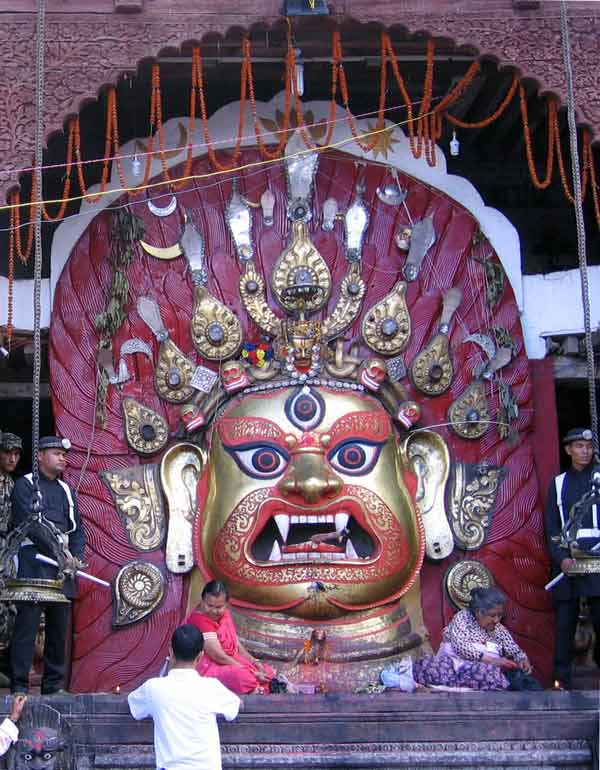
Śveta Bhairava, Bhaktapur, Nepal
Implications and wider issues: anti-intellectualism and relativism in American culture
Though I don’t have the space to expand much upon it here, it seems to me that Roche’s work exemplifies some disturbing trends in American spiritual
subculture(s) and American culture generally: trends of anti-intellectualism, relativism, and (as I call it) the artifice of individualism. It’s always
been the case that compared to Europe or India, Americans tend to distrust (or at least not particularly respect) experts in intellectual fields. Though
people are careful to go to experts when it concerns the proper functioning of their car or their body, they do not consult them before forming an opinion
on matters of culture or religion. It’s almost as if the general public is unaware that expertise in these fields can equal the level of detail and
sophistication found in the sciences. In the case of religion, however, the reason Americans don’t consult experts in the field is well known: the dominant
paradigm of American religiosity is one of individual experience free of the necessity for priests or clerics. (This paradigm is based in Protestant
Christianity, the dominant religion in early America.) What William James said in 1902 is still true today; that for most Americans, religion constitutes
“the feelings, acts, and experiences of individual men in their solitude, so far as they apprehend themselves to stand in relation to whatever they may
consider the divine.” Yet here’s where this otherwise respectable view goes wrong: many people don’t think they need expert opinion on anything to do with religion, even when the issues are historical or linguistic rather than strictly spiritual. Roche seems to be a prime example
of this phenomenon, but I have seen many more in discussions on social media. The implications of this are considerable. Most Americans don’t understand
anything of the worldview held by people of other religious faiths, from the mainstream Muslims they so easily lump together with the fanatics, to the
Hindus that they either exoticize or ridicule.
The latter part of the William James quote also points us in the direction of a related problem, that of relativism. This is the view that since each
person is entitled to his or her opinion, all opinions are basically equal. Some extend this to the belief that all views of reality are equally valid
(this is what is called relativism). Experts in philosophy have long since shown that relativism is either incoherent and nonsensical or else
masks a kind of nihilism (since all views can be equally valid only if they are all equally false, leading us to the conclusion that nothing is
really true).[26] The popular (though not thought-out) American commitment to relativism has bolstered
distrust of expert opinion, because after all, if everyone’s opinion is equally valid, why would you need experts?
Both anti-intellectualism and relativism are abundantly on display in the modern yoga scene. Students of mine have reported to me the scorn of their fellow
practitioners at the yoga studio; comments like, “Why do you need to study so much? Why don’t you just experience it? Don’t you know yoga is all about the
experience? Get out of your head!” Yet this opinion is at odds with the strong intellectual culture of premodern India, the birthplace of yoga. If the
texts that have survived are anything to go by, many practitioners of days gone by thought very deeply about what they were doing, why they were doing it,
and what views of reality were logically compatible with the spiritual experiences they were having. They didn’t think intellectual cultivation was at odds
with spiritual practice, probably because they understood that the former is necessary for a mature faculty of discernment. As a scholar-practitioner, I
sometimes despair about how wide the gap is between scholarly reflection on these issues and popular lack of the same.
The issues I have outlined perhaps shed some light on why modern American yogis often don’t see the value of critical articles like this one, and even
regard them as mean-spirited. Too often in American yoga, only positive language is approved, and critical discourse is frowned upon, in part because of
the hippie/relativist ethic that “everyone should be allowed to do or think what they like,” with criticism being seen as interference with this sacrosanct
principle. But in reality, carefully considered critical opinion usually arises from love and care and the desire to strengthen and benefit whatever is
being criticized. This is certainly true in the present case.
I well understand that Lorin Roche and most of those in his community have had blissful experiences with the poetry that he has created and will see my
analysis as unnecessary rain on their parade. Of course I have nothing against people enjoying themselves; my concern is whether they are also deluding
themselves. Do they think they have access to the teachings of an ancient Tantric scripture when in fact they don’t? Do they think they have a set of
practices that bring about spiritual awakening and liberation when in fact they don’t? Do they believe that the philosophies of hedonism and yoga are
mutually compatible when in fact they aren’t? I think these are important questions.
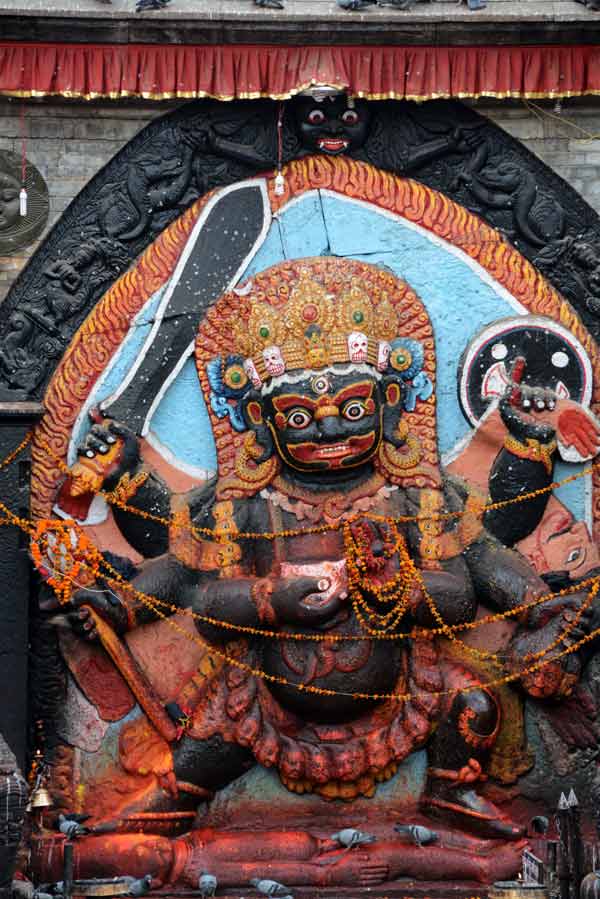
Kala Bhairav, Kathmandu, Nepal
Appendix: more translations from the Vijñāna-bhairava-tantra
There is never the slightest separation between Shakti and her Host (i.e. Shiva); thus, because there can be no separation between a quality and that in
which it inheres, the Power (śakti) of the Supreme Being is itself Supreme (parā). || 18
The power of fire to burn cannot be considered as separate from the fire itself. Shakti is only considered separate initially [as a teaching tool], to aid
in [our] entry into the state of insight (jñāna-sattā).* || 19
The nondual meditation of one who enters into the śakti-state will certainly develop into an expression of Shiva-consciousness (śiva-rūpī
). In our way (i.e. the Kaula way), Shiva's shakti is said to be the entryway [into Shiva]. || 20
Just as different directions [of any given space] are known through the light of a lamp or the rays of the sun, in the same way Shiva is known through
Shakti, O beloved. || 21
. . .
Imagine that [kuṇḍalinī] śakti, the subtlest possible form [of prāṇa], as rays of light shining upward from the root [of the
central channel] and peacefully dissolving in the highest center above the crown; [then] intensified awareness arises. || 28
[Feel kundalinī] śakti rising like a streak of lightning from one subtle center (cakra) to the next in succession. When She
reaches the upper[most] center, three fists above the crown, there comes the culmination, the Great Dawn of liberation. || 29
There are twelve [such centers] in sequence; properly associated with twelve vowels (a, ā, etc.). By fixing [awareness] on each one, in successively
coarse, subtle, and supreme [forms], in the end, [you find] God. || 30
Having quickly filled the crown center with that [prānic] energy, [and] having breached [the knot of māyā (above the palate)] with the ‘bridge’ of
concentration between the eyebrows, [and] having made one’s mind free of mental chatter, one ascends to the all-pervasive state (Vyāpinī) in the
[place] above all (i.e. the uppermost center above the crown). || 31
. . .
The concluding verses of the text recap the beginning, and further elaborate on the philosophy of the Vijñāna-bhairava:
The Goddess said: “If, O Lord, this is the true form of Parā, how can there be mantra or its repetition in the [nondual] state you have taught? What would
be visualized, what worshipped and gratified? And who is there to receive offerings?” (vv. 142b-144a)
The revered Bhairava said, “In this [higher way], O doe-eyed one, external procedures are considered coarse (sthūla). Here ‘japa’ is the ever
greater meditative absorption (bhāvanā) into the supreme state; and similarly, here the [‘mantra’] to be repeated is the spontaneous resonance [of
self-awareness], the essence of [all] mantras. As for ‘meditative visualization’ (dhyāna), it is a mind that has become motionless, free of forms,
and supportless, not imagining a deity with a body, eyes, face and so on. Pūjā is likewise not the offering of flowers and so on. A mind made
firm, that through careful attention dissolves into the thought-free ultimate void [of pure awareness]: that is pūjā. . . . Offering the elements,
the senses, and their objects, together with the mind, into the ‘fire’ that is the abode of the Great Void, with consciousness as the ladle: that is homa.
Sacrifice (yāga) is the gratification characterized by [innate] bliss. That which comes from destroying (kṣap) all sins and saving ( tra) all beings is the [true] holy place (kṣetra), i.e. the state of being immersed in the Power of Rudra, the supreme meditation.
Otherwise (i.e., without this inner realization), what worship could there be of that Reality, and whom would it gratify?” (vv. 144b-151)
“In every way, the essence of one’s own Self is simply the awareness of the joy of one’s innate freedom. Immersion into one’s essence-nature is here
proclaimed as the [true] ‘purificatory bath’.” (v. 152)
“Serving Her, remaining on the sacrificial path consisting of great joy, immersed in the power of that Goddess, one attains supreme Bhairava.” (v. 155)
by Christopher (Hareesh) Wallis, Ph.D.
March, 2016
show Christopher (Hareesh) Wallis, Ph.D.'s Bio
About Christopher (Hareesh) Wallis, Ph.D.
Christopher (Hareesh) Wallis was introduced to Indian spirituality at the age of six and initiated into the practice of meditation and yoga at sixteen. His
degrees include a B.A. in Religion from the University of Rochester, an M.A. in Sanskrit from U.C. Berkeley, and an M.Phil. in Classical Indian Religions
from the University of Oxford. He also pursued graduate work at U.C. Santa Barbara, and completed his Ph.D. at U.C. Berkeley on the traditions of Tantrik
Shaivism. He received traditional education at yoga āshrams in upstate New York and India in meditation, kirtan, mantra-science, asana, karma-yoga, and
more. He currently teaches meditation, yoga darshana (philosophy), Sanskrit, chanting, and offers spiritual counseling.
Hareesh is the Founder and Head Faculty of The Mattamayura Institute. His teachers, mentors, and gurus, in chronological order, include: Swami Muktananda;
Gurumayi Chidvilāsānanda (diksha-guru and mula-guru), Paul Muller-Ortega (Shaiva Tantra and Classical Yoga); Douglas Brooks (Shakta Tantra); Alexis
Sanderson (Shaiva and Shakta Tantra and Sanskrit); Marshall Rosenberg (Nonviolent Communication); Somadeva Vasudeva (Shaiva Tantra), Dharmabhodi Sarasvati
(Tantrik Yoga); and Adyashanti (Meditation). Hareesh is author of Tantra Illuminated: The Philosophy, History, and Practice of a Timeless Tradition.
show other content from Christopher Wallis
Other Content by Christopher Wallis
 If you value this knowledge please consider donating towards its production and dissemination worldwide in Sutra Journal. Be part of the effort to bring this knowledge to the world. Donations go towards the operating costs and promotion of the Journal.
If you value this knowledge please consider donating towards its production and dissemination worldwide in Sutra Journal. Be part of the effort to bring this knowledge to the world. Donations go towards the operating costs and promotion of the Journal.